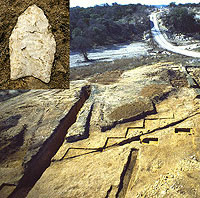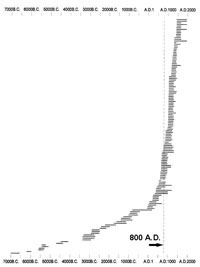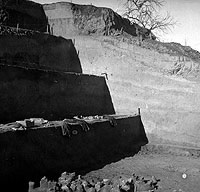Population Pressure
Over the 13,000-year span of prehistory, the Plateaus and Canyonlands region experienced an overall trend of increasing population. Evidence from the Early Paleoindian period, 11,500-9,700 B.C., suggests that population levels were low, most groups were relatively small, and there was plenty of unoccupied territory. Most known Clovis sites in the region are located in very favorable, well-watered spots, especially in the Balcones Canyonlands along the southern and eastern edges of the Edwards Plateau. These edges are major ecotones, zones where contrasting landscapes and ecological habitats sit side-by-side. It is not surprising at all that people would favor places that gave them ready access to different sets of natural resources: a great variety of plants, animals, rocks, minerals, and abundant water supplies.
Throughout prehistory the saw-toothed Plateau edge—the Balcones Escarpment and its associated canyonlands and major springs—was a highly favored occupation zone. The beauty and resources of the region are still powerful attractants today. The two largest and oldest cities in the region—San Antonio and Austin—occupy the same favorable location.
The densely wooded valleys of the major rivers draining the eastern Edwards Plateau—especially the Colorado River valley—were also highly favored occupation zones. Less is known about the early human history of these valleys, in part because most of the evidence is deeply buried in the river terraces and because many of the prime areas are now covered by the Highland Lakes and other major reservoirs. But we know that there were many major occupation sites along the Colorado River where Archaic period peoples returned to over and over again. Once again, the same areas favored in prehistoric times are places where modern settlement is concentrated today.
By about 2000 years ago in the latter part of the Late Archaic period, the entire region seems to have been densely populated. The edge and river valley zones were still part of the most highly sought-after territories as judged impressionistically by the concentration of sites and the dense nature of many of the site deposits documented there. But there is widespread evidence that people were living in sizable numbers all across the Plateaus and Canyonlands region, even in the driest areas, along the smallest creeks and intermittent springs that flowed only during wet periods. This is also when root-baking begins to peak as judged by the radiocarbon dates from burned rock middens. People were eating lots of roots and bulbs--not because they wanted to, but because they had no other choice. Root baking it is hard work that pays off poorly because it yields barely enough caloric energy to cover the calories expended to gather and process the roots. The sugary yield might have been enjoyed, but at a health cost—the incidence of dental decay was high.
What does all this mean? The most likely explanation is population increase. More and more people in the region through time forced some groups to move into smaller and less-than-favored terrltories and resort to eating less-desirable foods. Their bones show high incidence of dietary stress—probably caused by seasonal starvation. We can also guess that the Late Archaic was a time of increasing violence and conflict between groups and tribes competing for limited resources.
We do not yet understand how population densities ebbed and flowed through time—as surely they did, but so far we lack the convincing and quantifiable evidence needed to estimate population levels through time. But based on continent-wide patterns, it is likely that the entire region, especially the eastern Plateau, saw increasing populations, dietary stress, and conflict through prehistoric time, not peaking until the last millennium of prehistory (about 500-1500 A.D.). This is a major research topic for the future.


